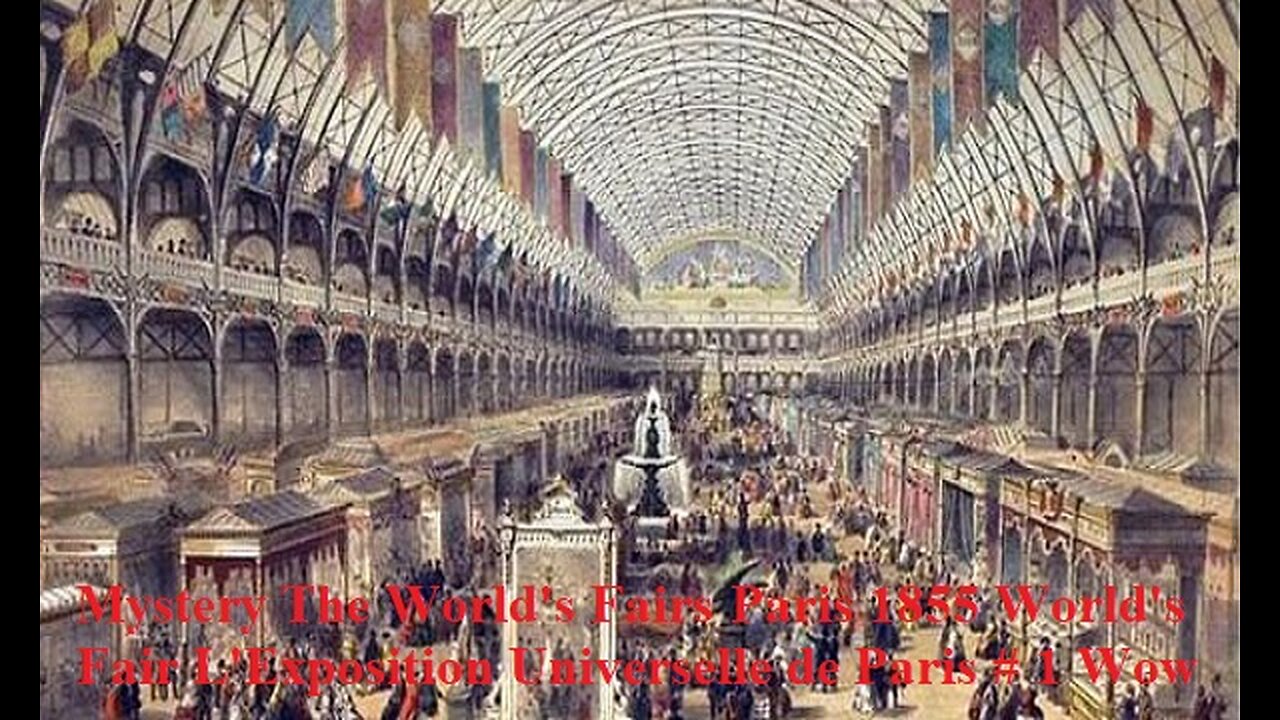Premium Only Content

Mystery The World's Fairs Paris 1855 World's Fair L'Exposition Universelle de Paris # 1
Mystery The World's Fairs Maybe the History we've been told is a lie! Were some ancient buildings built by a different race and their true history was covered up? Did ancient peoples have advanced forms of technology that have now been forgotten ? Was the massive kingdom of Tartaria visible on ancient maps much more advanced than we realize? This sub is an open forum for collaborative discussion of all topics "Tartaria" related, including Mud Flood, Tesla, AntiquiTech, Free Energy, Conspiracies, Hidden History, etc.
I wonder if this video has been posted here before? If yes, then i am not sorry for posting it again, because its just one helluva epic video. If not, I highly recommend watching it if you are interested in perhaps how Tartarian technology worked. I am still thinking about all the stuff he said and points out to us. As its a lot to deal with and can shake one up. I find it fascinating though.
Could it be that this civilization, split off from our official historical line of development, is behind many of the events of the 20th century?
And what of the World's Fairs? Were a large proportion of the World's Fair Buildings actually built from scratch, as the official historiography claims? There is much to suggest that the robber barons of the industrial age not only hid once widespread technological knowledge from us, but that they also hijacked some of the impressive architectural masterpieces in which parts of this knowledge was displayed.
Some of the buildings from the World's Fairs still exist today, and they are obviously not made of plaster or similar fragile materials. Were they subsequently rebuilt to be permanent structures? Is it even possible that the elaborately designed Expo sites were built with the technological capabilities of the time within just a few months, only to be destroyed again a few months later after the exhibitions had ended? Or is it plausible that after a great catastrophe the worldwide remains of the preceding high culture were not only systematically destroyed, but also pressed into an image of history imposed on us?
Some available information suggests that even after the worldwide, game-changing event we call the Reset or Mud Flood, there still remained countless complete and beautiful cities that were conquered by a new power elite and then repurposed as "World's Fairs".
Especially in America, the so-called New World, the many Greco-Roman cities would have been difficult to explain because in contrast to Europe, the Americas do not have an official greco-roman history.
The more carefully one investigates, the more difficult it becomes to find plausible explanations for the construction and destruction of these extraordinary and huge exhibition areas.
The official version about the World's Fairs can be summarized as follows: People in the 19th century loved Greco-Roman architecture for reasons unknown, so it was extremely important to the architects who organized the World's Fairs between 1850 and about 1914 to build in a classical style.
(Note: With World War I, classical architectural ambitions in Europe ended abruptly and many exhibitions also did not take place as planned. It was only in the wake of fascism that there was a return to ancient design principles, but these were often implemented superficially and were mainly applied to a few representative magnificent buildings. After the Second World War, on the other hand, classical architecture was deliberately replaced with new trends - e.g. Bauhaus and Brutalism. Officially the intention was to create an aesthetic distance to fascism, but in all likelihood its purpose was to cut the connection to the Old World through soulless, brutalistic architecture.)
No effort was spared for the world's fairs, enormous amounts of work went into creating complex statues, ornaments, columns, parks, buildings, and even the world's largest organs. No expenses were spared in the making of these massive structures. Made of plaster and linen or hemp fibers, they were only intended to last for the duration of the Expo. However the attention to detail was so great that purely visually there seemed to be no difference between the Expo buildings and the classical splendor-buildings of antiquity. The purpose of the World's Fairs was to make the supposedly "new" technologies discovered during the Industrial Revolution palatable to the masses, to create new markets. In the end, most of the buildings were torn down, with only meadows or empty parks remaining.
How Many World Fairs Did Paris Host in the 19th Century? World Fairs were significant events during the 19th century, and the legendary fairs in Paris showcased artistic and industrial excellence. The 19th century was a momentous period in Parisian history, when significant breakthroughs in art, industry and science were made. One of the most outward expressions of Parisian success were the Paris World Fairs, which cemented the city’s place as a world-leading political capital. These vast events spread out across the entire city and included new temporary and permanent buildings, along with displays of industrial developments and works of art from around the world. Some of the highlights of the Paris World Fairs even went on to become iconic, permanent landmarks, including the Eiffel Tower, and the head of the Statue of Liberty, which later made its way to the United States. Below are the five Paris World Fairs that altered the course of history. 1. The First Paris World Fair: 1855 The very first Paris World Fair took place in 1855. It was organized by Emperor Napoleon III as a promotional tool to assert his new position in power, signifying a landmark moment in France’s history. The World Fair centered around a brand-new exhibition hall – the Palais de l’Industrie on the Champs Elysees. Two new smaller buildings also accompanied this space – the Galerie des Machines and the Palais des Beaux-Arts. Inside these exhibition rooms were a series of world-renowned exhibits dedicated to industry. Meanwhile, a temporary construction next to the Galerie des Machines was designed by the architect Hector LeFuel to house artworks from around the world.
2. The Fair of 1867 The second World Fair in Paris was also organized by Napoleon III to take place in 1867. Again, the event was a powerful strategic move, aimed at bringing attention and political gain to Paris. The main exhibition space for the 1867 Paris World Fair was the Palais du Champ-de-Mars, built by Frederic LePlay, with help from the up-and-coming engineer Gustave Eiffel. This exhibition hall was circular in design, and the fair designers took advantage of this layout, arranging industrial exhibits in the outer circles, while the inner circles were dedicated to art. In the center, a small building housed a display dedicated to currency and coins from around the world. It was a momentous event, larger than the previous one, with a series of pavilions, restaurants and amusement parks constructed around the central building to draw huge crowds.
3. Paris World Fair of 1878 By contrast, the 1878 Paris World Fair took place in a very different political climate. Against the backdrop of the Prussian War, the Paris commune and the downfall of the empire, France was in a vulnerable and unstable state. The officials of the Third Republic decided that a World Fair could bolster France’s popularity on the international stage, even if they could barely afford it. One of the highlights of the fair was the recently completed Head of the Statue of Liberty, which went on display for a brief spell in a Parisian park before being shipped to the United States. Other highlights included the temporary construction of the Palais du Champ-du-Mars (Gustave Eiffel helped with its design!), and the permanent Palais du Trocadero, which later became a concert hall.
4. 1889: The Year of the Eiffel Tower The 1889 Paris World Fair was the second to take place in a republican regime in France. It was a historically significant year for France, marking the 100th anniversary of the French Revolution, so the pressure was on to create something spectacular. The fair was larger and more ambitious than in previous years, taking place in the Palais du Trocadero and the Champ-de-Mars, while several temporary pavilions and pop-up spaces formed satellites around it. Meanwhile, East of the main site, the Esplanade des Invalides showcased a display dedicated to colonial art. But by far the greatest and most controversial aspect of the fair was the unveiling of the Eiffel Tower, which divided public opinions and caused an international sensation. Only meant to be temporary for 20 years, the tower is now an iconic landmark for the city.
5. The Grand Event in 1900 The fifth World Fair in Paris was in 1900, a centenary display of epic and ambitious proportions. Paris was also hosting the Olympic Games in the same year, making the city the center of public attention around the world. A series of new buildings popped up, including the Grand Palais and the Petit Palais, while the government extended the Esplanade des Invalides and Petit Palais. They even painted the Eiffel Tower bright yellow to mark the occasion! A series of visitor attractions pulled in tourists far and wide – these included moving walkways (trottoirs roulants), the Electricity Palace, and a series of night-time water and light displays to dazzle the public at the dawn of a new age.
Dates Open - May 15 to November 15, 1855. Exhibition was open on Sundays.
Attendance - 5,162,330 visitors, of which 4,180,117 for the industrial exhibition and 935,601 for fine arts.
International Participants - 42 nations and kingdoms and more than 17 colonies. Other sources state 53 foreign states and 22 foreign colonies represented, plus France, three provinces of Algeria, and 8 French colonies.
Total Cost - Total Cost $2,257,000, with Palace of Industry (paid for by French government bringing total cost to aorund $5.7 million). Loss of $1.6 million reported.
Site Acreage - 34 total acres with 24 acres covered. Location was the Champ de Elysees.
Sanction and Type - Prior to the Bureau of International Exhibitions. Paris 1855 would be considered a small scale registered event today.
Ticket Cost - Season ticket - $20, Daily ticket 20 cents (1 franc), Friday (reserved day) $1, Sundays 8 cents.
The French were still at war in the Crimea with Russia and London had hosted the first World's Fair in London in 1851, so Napoleon Bonaparte III (not the original) announced that this time their series of national expositions would be international and it would be held in 1855 with a newly constructed Palais de l'Industrie as its main building.
On March 27, 1852, Napoleon III decreed construction of the overdue Palais de l'Industrie, originally meant to hold national expositions. It was to be built by a private holding company, the Compagnie du Palais de l'Industrie, which would hold title until 1899, then it would revert to the government. Government donated the land where today's Grand-Palais is, guaranteed shareholders 4% interest on investment, and conceded to Compagnie the right to charge admission for events there. The 1855 Universal Exposition was announced by decree on March 8, 1853.
The exposition was to be the first to include the fine arts. They were housed in the Palais des Beaux-Arts, a temporary building behind the Palais de l'Industrie. The universal exposition of Art encompassed the works of 28 countries, including France, Spain, Italy, Belgium, Germany, which was not yet unified, (work exhibited under sponsorship of Prussia, Bavaria, Saxony, and other smaller principalities), and Great Britain. Russia did not participate due to the Crimean War against France. In some sections of the exposition, Russian businessmen did exhibit.
Exhibitors filled the four buildings despite their late finish; the total number of exhibitors were 23,954 with French 11,986, and foreign 11,968. 21,779 of the exhibits were in the section on industry, 2,175 for the fine arts section.
Above photo. From stereograph of the Palais de Industrie 1855, George Stacy, 1865. Courtesy Library of Congress. Below: Lithograph of the interior of the Palais de l'Industrie during a ceremony for exhibitors, November 15, 1855. Photo courtesy University of Maryland Digital Collections.
The Palais de Industrie was the main building of the fair, one of four constructed. It was permanent, 765 feet by 354 feet, made of stone, 545,934 square feet, with a roof of reinforced glass. It would last until torn down in 1897. There was a large second building, round, surrounded by a large gallery which displayed the Crown Jewels of France. A third building was a large temporary annex, 446,955 square feet, on the right bank of the Seine River; it held machinery and raw materials. The fourth building was the Palais de Beaux Art with 173,768 square feet.
The outcome of the exposition was a financial loss borne by the state and the Palais not considered as special as the London Crystal Palace. The short span between those two fairs may have contributed to the loss, although the appearance of Queen Victoria and Prince Albert to the fair showed that it did have international backing. They were the first British monarchs to set foot on French soil for over four hundred years, since 1422. That cemented the Franco-British alliance, no small feat of itself. Some state that the confusing exhibit classifications were the cause to the loss. Probably hard to pin it on that.
Perspective of Historians
Historian Margit Mogenson - "All these exhibitions were projects of the official France and as such born to provide "national pride" - for the emperor (1855 and 1867) and for the republic (1878). However it is more difficult to say to which extent the citizens and the public agreed or matched the official policy, especially early in the period (1855)."
International Participants
Nations and Colonies
Listed as Exhibitors:
Germany (not country till 1870); Anhalt-Dessau et Coethen, Grand Duchy of Baden, Bavaria, Brunswick, Frankfurt, Hanover, Hesse, Grand Duchy, Duche de Nassau, Prussia, Saxony, Duche de Saxony, Hanseatic Towns, Wurtemburg, Other German States.
Austria, Belgium, Denmark, Spain and Colonies, Pontifical States, Greece, Italy, of which (not nation till 1861); Sardinia, Two Sicilies, Toscany. Luxembourg, Norway, Netherlands (Pays-Bas) and Colonies, Portugal and Colonies, United Kingdom, United Kingdom Colonies - (Australia, Canada, British India, Guyana, others including Malta, Ionian Isles, West Africa, Cape of Good Hope, St. Helena, West Indies, Tasmania, New Zealand).
Sweden, Switzerland, Turkey, Egypt, Tunisia, United States, Latin America - Guatemala, Costa Rica, Argentina, Paraguay, Peru, New Granada (Columbia), Hawaii.
French Colonies - Martinique, Guadaloupe, Reunion, Senegal, Algeria, Gabon, French India, French Oceania, French Guyana
Expo Tidbits
Loss of the exposition measured against possible $10-30 million estimated benefit to Paris in 1855 from visitors. Estimated 160,000 foreign visitors, including 40,000 British.
British government spent $250,000 for expenses of their national exhibit.
The McCormack reaper and Goodyear treatment of Indian rubber recieved grand medals of honor.
Paris 1855 introduced the sewing machine.
High one day attendance: Sunday, September 9, 1855 - 123,017.
Legacies
Palais de l'Industrie (until 1897).
Those in Charge
Organizers for the fair included Frederic LePlay, Commissaire ge'ne'ral, and Prince Napoleon, President of Exposition, cousin to Napoleon III himself.
Sources: London Times; New York Times; Fair News; Ephemeral Vistas; Historical Dictionary of World's Fairs by Alfred Heller; History of Fairs and Expositions; Worlds Fairs from 1851-1893; Les Fastes du Progres; Official Report of Paris Exposition; Reports of the U.S. Commissioners to Vienna 1873; Bureau of International Exhibitions; Art & Politics of the Second Empire, Mainardi; World's Fairs from London 1851 to Chicago 1893; History of the Louisiana Purchase Exposition.
In 1855, the second World’s Fair opened in Paris; Response to the British challenge of the World’s Fair of 1851 . Presented as the "Exhibition of Agricultural, Industrial and Fine Arts Products", it focuses on fine arts and agriculture, enabling to enhance the many French artists and the wealth of local products, including wine. For Napoleon III , it is a matter of affirming the existence of the Second Empire , a young regime faced with European and multi-decadal powers.
In response to the Crystal Palace, Napoleon III built the Palace of Industry, also designed as a large canopy. Organized in 30 classes divided into 8 groups, the Exhibition welcomes all nations under the same buildings, so as to be able to compare; A formula that will soon give way to separated National Pavilions. The Palais de l'Industrie exhibits industries, textile and chemical products, as well as furnishings in which cabinetmakers are standing out like Fourdinois, awarded a Grand Medal of Honor for an enamelled ebony cabinet, or Jeanselme to whom Napoleon III purchased a large hunting buffet for his antechamber at the Palace of Saint-Cloud. The house Tahan also makes sensation with a large aviary which is several times reproduced in the international newspapers, and exhibits unique furniture inlaid with the porcelain marquetries of Julien-Nicolas Rivart .
The World’s Fair is also the occasion to present small and great inventions which in the long term have led to technical and social revolutions, visible all along the Seine in the Galerie Annexe des Machines. In 1855 were presented : the pendulum of Foucault, Mr. Loysel's percolator to make coffee flow, and the technique of galvanoplasty, which was taken over by the firm Christofle for the realization of bronze and will contribute to its success, or the Singer sewing machine that marks the beginning of the modern era of fashion.
Between the Palais de l’Industrie and the Galerie Annexe des Machines, the Rotonde des Panoramas, designed as the central pivot of the Exhibition, hosts luxury industries. Finally, 5,000 paintings are presented in a specific building called the Palace of Fine Arts. The 1855 World’s Fair is a turning point for French painting, which consecrated the great romantics and gave a chance to a certain Gustave Courbet to make his counter-exhibition with the Pavilion of Realism.
The exhibition is a success with 14,000 participants and approximately 5,000 visitors, including Queen Victoria at the inauguration, or the Emir Abd-El-Kader, a great opponent of the colonization of Algeria, to whom Napoleon III gave freedom. And in a crowd of anonymous, some young still unknown artists are present, such as Degas, Pissarro, Renoir.
Paris hosted five World Fairs. The first of these World Fair’s occurred in 1855 and was called the Exposition Universelle. It came about after Britain hosted the 1851 Great Exhibition of Works of Industry of all Nations. Napoleon III, nephew to Napoleon Bonaparte, hoped to outdo England’s famous exhibition with its Crystal Palace that was used to house that exhibition. He also hoped to increase France’s reputation and popularize his political role in the world. Although Paris’s Exposition Universelle was not a financial success, it did become a political success in that it legitimized the Second French Empire and put Paris on the map as an international city.
The Exposition Universelle ran from May 15 to November 15, 1855 and the number of visitors coming to Paris to attend the exposition had newspapers reporting on the constant crowded state of Paris. Everywhere people looked there were crowds. The number of visitor was overwhelming and caused a correspondent of Scottish Guardian to report, “Anything like the crowds now flocking into Paris form all points of the compass I never saw during a residence of many years, and I am very certain that the like was never seen in all foregoing times.”
To handle the immense crowds trains arrived regularly but still the railway system could not handle the crush of visitors or the quantity of luggage that accompanied these travelers. Those that did not have reservations found it impossible to locate somewhere to stay. One foreign visitor reported “vainly for two hours I tried all the by-streets that I could think of … At every door the uniform answer, ‘quite full’ was given.” Moreover, hotel and lodging-keepers were exhausted from turning people away.
To count all the visitors that attend the Exposition Universelle, there was a new invention — the turnstile. Official reports stated that 5,162,330 visitors attended. Moreover, for the first time visitors paid an entrance fee, which generated complaints and created controversy throughout Paris. That may have been part of the reason why the exhibition was not a financial success: It generated about one-tenth of its actual cost, which has been estimated to be upwards of $5,000,000 dollars.
The center of the exposition was its main building known as the Palais de l’Industrie. It was located on the Champs Elysées, and construction of this grand building began in 1852. It was argued that a massive building was needed so that future exhibitions could be accommodated, and, for that reason, a stone structure 850 feet long and 350 feet wide was built. Unfortunately, despite the building’s massive size, the Palais de l’Industrie still could not house all the industrial products and two other temporary structures were also erected — the Galerie des Machines and the Palais des Beaux-Arts.
There were other problems with the Palais de l’Industrie that London’s Morning Post noted stating:
“The main building itself is ill adapted for the purpose; you have four stone walls, of no use but to keep out light, with a structure of iron and glass, wholly independent of the walls, put down within them. The unnecessary quantity of iron used would lead to the belief that the contracts were to be paid by the cwt. The galleries as so wide (85 feet), and so heavily constructed, that beneath them is in darkness; and there, in consequence, you may wander in solitude through long alleys with ranges of cases on either side — gloomy, depressing, and deserted. The staircases … are the best features of the building, and are unquestionably effective and elegant. On entering the great nave — full, by the way, of charming things … — the small size of the building surprises one. You find that from ‘out to out’ it is not very far from half the length of the building in Hyde-park (834 feet), but it does not look one-fourth the length. Why is this? A little examination will give a reason. The arched roof has gable ends at the terminations, and these ends occur not at the extremities of the building … but in line with the face of the latter; and then, to make the matter worse, these ends are glazed with stained glass, representing — one, France … Another error in judgement is shown in the great size of the stalls or cases, which are built up is the nave twice as high at they should be, or need to be. Look, again, at the shafting for the machinery in motion, in the Annex … ponderous and absurd; and with all its heaviness not without a great weakness in construction.”
Despite the problems that the English may have saw with the Exposition Universelle, a catalog described how Frenchmen viewed the exposition:
“We wished that the Universal Exhibition should not be exclusively an attraction for the curious, but a great school for agriculture, industry, and commerce, and for the arts of the whole world.”
Because of this there were a large variety of exhibits related to mining and metals, pharmacy and medicines, manufacturing and industry, furniture and decorations, and naval and military arts. The exposition also allowed visitors to see large-scale exhibitions and view the operation of such things as steamships and steam locomotives. Further, it “distinguish[ed] itself from the English model by integrating spiritual as well as material accomplishments.”
There were many well-known visitors to the Exposition Universelle, including Britain’s Queen Victoria, her husband Prince Albert, and their daughter. Of their visit the Evening Freeman reported:
“To-day, at half-past eleven o’clock, the Emperor, the Queen, Prince Albert, and the Princess Royal visited the Palais de l’Industrie. Admission was granted only to the imperial commissioners, the juries, season ticket holders, and exhibitors. The price of a season ticket is twenty-five francs, and numbers paid the sum to-day sooner than be deprived of so favourable an opportunity of seeing the Queen and the Emperor. At half-past eleven the cheers of the crowd outside, and a loud flourish of trumpets within, announced the arrival of the royal party, who were received by his Imperial Highness Prince Napoleon, president, and the other members of the Imperial commission. Her Majesty’s reception and that of the Emperor was far more enthusiastic and complimentary than on any other occasion since the arrival of the Queen at Paris. As they pass round the great halls the shouts of ‘Vive la Reine,’ ‘Vive l’Imperateur’ were frequent and warm. … His Majesty supported the Queen on his right arm. Prince Napoleon walked by the right hand side of her Majesty; Prince Albert, with the Princess Royal leaning on his arm, followed, the Prince of Wales walking at the other side of his sister. … The entire party were dressed en ville, the Queen wearing a blue bonnet and scarf, and the Emperor a black frock coat, grey trousers, light scarf, and yellow gloves. The royal party first walked round the Great Hall. On passing the glass-case containing the productions of Wm. Dargan and Co., Chapelized, her Majesty’s attention seemed at once arrested by seeing the name of that distinguished Irishman which appeared on a card over the glass-case. The Emperor directed her Majesty’s attention to the Irish fishery models, which she looked at, observing to her imperial host that she had seen them before. From the main apartment the royal party passed to the Panorama and Annex which they visited in succession.”
Besides the exposition itself, there were also several associated events. At least one of these associated events was deemed “dreadfully mismanaged.” It was a fete given by the exhibitors to honor Napoleon III and the members of the Imperial Commission. Besides too few chairs for participants, the orchestra played “Vive l’Empereur” several times before Napoleon III actually appeared. There were also drunken young people who began dancing strangely having been “unusually excited by the champagne [poured] … with a most liberal hand.”[7] Another problem was related to “paletots and outside coats of the guests.”[8] These items became so mingled together it was impossible to know who owned which item and guests became so unruly trying to sort it out that police were called. This resulted in guests having to return the following day to claim their belongings.
At the end of the exposition, medals were awarded for the best exhibited items. The medals were presented on November 15 when the winning objects were brought into the center nave making it easy for spectators to view the winning objects. There were 500 gold medals awarded that were valued at £40 each. There were also a proportionate number of silver and bronze medals. On one side of these medals was the “profile of the Emperor, with the words, ‘Napoleon III-Empereur.’ On the reverse … the Imperial arms ornamented with palms and wreaths, surrounded by the arms of the different nations, and surmounted by a scroll, bearing the inscription, Éxposition Universelle, Agriculture, Industrie, Beaux Arts — Paris, 1855.'
With the first Exposition Universelle being deemed a success, more Exposition Universelle’s followed. The second exposition was held in 1867 and Napoleon III was able to more effectively exploit this exposition. By the time the third exposition was held in 1878, the Third Republic was in power, and, they, similar to Napoleon III, wanted to assert their dominance in the world. The next exposition occurred in 1889. It was also held under the Third Republic, as was the last exposition in 1900. However, the exposition of 1900 was much grander than previous expositions partly because Paris became the first city to host the Olympic games outside of Greece.
Purpose of the World Exhibitions
If it is true that many of the buildings at the World's Fairs already existed and were only renovated, then the destruction of these buildings is one of the largest cover-ups in recent history. Also, this would be further proof that pretty much all countries were already controlled by the cabal 100 years ago, and modern politics was intended from the beginning as a means to infiltrate and control cultures. The systematic destruction of knowledge and the theft of cultural goods and property by the church continued seamlessly with the advent of more contemporary nation states. With the help of a central monetary system imposed on us, state-legitimized robbery is still the main cause of the transfer of wealth and possessions into the hands of a few.
The misappropriation of majestic old-world building sites by the new post-colonial power elite happened at the same time as other events that all seem to be connected. Thus, from the mid-19th century onwards, not only were World's Fairs held in oversized and far too expensive buildings that were completely inappropriate for them, but at the same time the first psychiatric hospitals ("insane asylums") were being built. Just like the world exhibitions, these psychiatric hospitals were architecturally unsuitable for the defined purpose. Architecture always reflects the consciousness of the builders and is defined by its purpose. However, we would expect industrialists to build simply and economically, to use steel and concrete, and by no means to demolish their buildings immediately, but to try to generate income from land and buildings for as long as possible. But we see just the opposite - the buildings at the World's Fairs are detailed, ornate, aesthetic, and far too large and expensive for their purpose. They represent something completely different from the world we know. They represent ancient Rome, the classical ideals of the beautiful, the true, the good; the pursuit of the divine and perfection.
The World's Fairs connect two completely opposite eras (or cultures) that should have no points of contact at all - the world of the industrial robber barons and an old world that we can no longer remember, but in which the economic principles we know played no great role.
Greatest Story Ever Un-Told 10 Parts Set and This 1893 World Columbian Exposition In Chicago Is Really A 1,000 Years Old City From Past Antiquitech Tartarian Empire and the True Believers in the “Tartaria” conspiracy theory that 100s of old world fairs 1801 thru 1940 era are convinced that the elaborate temporary fairgrounds built for events like the Panama-Pacific International Exposition in San Francisco in 1915 and 100s of other city were really the ancient capital cities of a fictional empire !
"Expositions are the timekeepers of progress. They record the world's advancement. They stimulate the energy, enterprise, and intellect of the people; and quicken human genius. They go into the home. They broaden and brighten the daily life of the people. They open mighty storehouses of information to the student. Every exposition, great or small, has helped to some onward step." President William McKinley, speaking at the 1901 Pan-American Exposition in Buffalo, NY.
The 1893 World Columbian Exposition in Chicago inaugurated an age of great fairs and expositions in the United States whose influence is felt to this day. The Chicago Exposition and the similar events that followed in Buffalo, NY; St. Louis, MO; Seattle, WA, San Francisco, CA and New York, NY dramatized technology and the fine arts, and illuminated the era ahead, as industrialism took hold, immigration peaked, science moved ever forward, and a vibrant, multi-faceted American music culture grew throughout the country.
Though the 1876 Philadelphia Centennial Exposition in Philadelphia had been a great success, the Chicago Exposition took its immediate inspiration from the Exposition Universelle held in Paris in 1889. Like all previous world's fairs, the Paris exposition hosted music and other entertainment among its exhibits, but in greater variety and on a much larger scale. A major work, Esclarmonde, was commissioned from French composer Jules Massenet and was performed nightly. Music from all over the world was heard, including Javanese gamelan, which was to have a profound effect on composer Claude Debussy. Fairgoers could also hear indigenous music at the village nègre, where some 400 Africans from European colonies spent the duration of the fair demonstrating their culture and crafts. A similarly conceived Algerian Village was also an attraction.
The organizers of the Chicago Exposition would try to match or outdo the 1889 Exposition in every way. For awhile, they even thought of creating a structure taller than the Eiffel Tower built for the 1889 fair, and the tallest building in the world at the time. In the end, they settled for a spectacular city-within-a-city that sprawled over 600 acres and featured 65,000 exhibits. "The White City," so named for its many white buidlings that were made even brighter by the night-time illumination supplied by General Electric, captured the imagination of the country, and drew over 27 million paying customers during its run from May 1st to October 30th, 1893. Within its walls, fairgoers could marvel at the ever-multiplying technological wonders of the age, enjoy art exhibits, concerts and sports; listen to lectures on various topics, view short films in the world's first dedicated movie theater, or ride the original Ferris Wheel.
The basic human desires for community, stories (the more outrageous the better) and the need to feel like a protagonist in a wider struggle are what pulls us from moments of real social, economic and cultural dislocation into fabricated histories. Buildings and cities are made to grow old, to outlast people, and to be a testament to these cultural histories. They’re a yardstick for a culture’s ability to endure. When they’re not given the chance to do this, the contradiction can break something loose, and send people scavenging for cultural memory that feels ancient enough to anchor them in an uncertain now.
Sullivan aptly describes here the poisoned rebirth of pseudo-classicism in the 20th century - the attempt to imitate the old structures without having understood the architectural principles. We always see two fundamentally different types of architecture in the photos of the expos - on the one hand, the massive, classicist buildings, with uniform and harmonious proportions of the golden ratio. They do not differ in the slightest from the real European renaissance buildings, because in fact they come from the same era. On the other hand, we also see cheap-looking, actually temporary buildings made of plaster and other cheap materials, which do not originate from any known historical epoch and which were obviously built with the intention of tearing them down again as quickly as possible.
Many temporary structures were erected around the old buildings for the Expos - e.g. cheap pavilions, walls made of plaster and imitations of famous buildings, but after the Expos not only the temporary but also the old buildings were demolished.
Did the World's Fairs perhaps serve, among other things, as an instrument to give people a national identity after the unified culture had collapsed? The separation into nations seems artificial - the Slavs, for example, seem just like the Germans of Nordic origin and thus part of the same people. The term "Slav" originated from the pejorative term "sclavi", was put into the world by the Vatican and stood for the "pagan" tribes of Europe who did not want to submit to the monotheistic power apparatuses. After the successful infiltration of the German cultural area, only the pagan Eastern Europeans were referred to as "Slavs". In fact, most of the nations we know today were not founded until after 1850 - modern Egypt, for example, only in 1953, after the British conquest. Illyria, the homeland of the Illyrians, became the Balkans after annexation by France. Free Tartary became Uzbekistan, Persia became Iran in 1935, the Ottoman Empire became Turkey in 1923, and so on. The old words have a meaning - our whole past resonates in them. When these words are spoken, that alone establishes a real connection with the past. By losing these words, we also lose that connection, and with it, the connection to our ancestors. Meanwhile, our world is divided into various soulless administrative units, controlled by a small secret elite.
It was at the Expos that people first came into contact with the "new technologies" - telephones, railways, electric light (i.e. the light bulb), wireless communication, incubators, cars, photography, films. In addition, the supposed realities of life in the colonies were also frequently depicted (Africa, South America, etc.). The creation of the patent system played an important role in building the monopolies - because only with patents it was possible to own knowledge and thus technologies, and thus control people.
The foundation of the world we live in today was laid then during the time of the world expositions. The technological knowledge of the old world was selected: One part of the knowledge was kept secret, the other part was presented to the public. One of the most important criteria in this decision-making process was whether a technology could be controlled by a central authority. Any form of free energy must have been very dangerous to the forces that controlled the robber barons of the industrial age from the shadows. It is important to understand that these industrialists had not earned their wealth themselves - they were born into elite families and chosen to play a predetermined role.
Only since the dawn of the 20th century has the attitude prevailed that one must take something from others in order to be able to have something oneself. Competition took the place of cooperation. These two opposing world views - cooperation and competition - can be visualized as follows: With a circle and a pyramid.
The competition system is pyramidally organized. It involves an authoritarian chain of command that requires absolute obedience. At the level of the intelligence services, this system is represented by the "need-to-know" principle. Competitive thinking can only arise in a hierarchically organized society. In this society, energy flows from the masses at the base upward to the top of the pyramid, where it may even be absorbed or consumed by non-earthly entities. At the top seems to be what is named in mythological, religious and esoteric lore as Satan, Antichrist, Evil, or the Demiurge. At the base of the pyramid are people who feel powerless, basically slaves. Success in this system is defined by making it "to the top". This always implies that on the way up you oppress other people - take something away from them. The further up you go, the more powerful you feel. Energy is represented or symbolized by money in this system. The money system was built in such a way that, in the sense of the pyramidal system, it gradually directs people's life energy to the top of the pyramid. We can assume that this is also where the true reason for the existence of the fiat money system is hidden: to rob people of their life energy.
We already encounter the connection between parasitic, paranormal beings, the monetary system and the oppression of humanity in the work "Momo" by the author Michael Ende: men in grey, called time thieves, steal people's time. These interdimensional parasites convince the adults that they can save time by depositing it in a time savings bank. The adults believe the promises of the men in gray. In reality, the more they save, the less time they have - the time they save is lost to them. Life gradually becomes sterile and bleak. Buildings become standardized and all look the same, just like clothes. No one lives in the present anymore, no one has time for each other and life becomes hectic. Only the children recognize the cold, vicious nature of the gray men, as they are still in touch with their own aliveness. The adults fall prey to the idea of having to save time and so their lives become increasingly bleak and grey. But the Gray Men are gradually able to cast their spell over the children as well. Only Momo can resist the cold, psychopathic power of the Grey Men. Outside of space and time, she defeats the Men in Grey, frees the stolen time, and gives people back their vitality and the love in their hearts.
It's amazing, by the way, that in the novel Momo lives in an old, decaying Roman amphitheater surrounded by dreary, modern new buildings. Momo represents the connection to the old world. She represents life. When Momo defeats the men in gray, the last one says with relief, "Finally it's over!" Michael Ende realized that evil has no existence of its own. It is only a shadow, a black hole, the absence of something. Evil can only exist as long as there are people running away from themselves and their own aliveness. The parasites are our own creation. The destruction of the parasites is the triumph of man over his own contradictory nature and his dark side.
Power and powerlessness are in truth only two sides of the same coin, and also in karmic terms everything has its price. Every experience of power is always based on a corresponding experience of powerlessness, even if these experiences are separated on a temporal level. A good metaphor for the pyramidal system is a black hole that absorbs all light, consumes everything and releases nothing - it is a one-way street. That's why secret societies exist in the first place - in a pyramidal system, the relevant decisions have to be made in the shadows and no one is allowed to know the people making the decisions. The system is like a hydra, and we can only see some of their heads. Evil is always absorbing, consuming, calculating, inward looking. It closes itself to life, to exchange and to truth.
Possibly in the old world, on the other hand, people were integrated into a cycle. Everything was cyclical and in balance. People knew that they had nothing to lose by giving to others. In these communities, people lived for each other - on an energetic level, energy flowed freely between them without flowing outward. In these small, healthy communities there were no authoritarian hierarchies, no chains of command, no parasitic forces. Authorities evolved naturally, and people with natural authority were keen not to abuse their power, as this would have resulted in expulsion from the communities. The system, built on cooperation, includes multiple rings running concentrically outward. In the center is the "heart" - the wisest, most intelligent, most capable people in the community. Unlike the pyramidal system, these people do not hide, for they need not fear transparency. Even architecture reflected this concentric system. For example, in the round city of Baghdad, or Atlantis, which was supposedly built in rings. From the center or heart of the city, life moves outward in rings. The city wall separates the city from the outside world, creating a self-contained, living system. Goodness is outwardly radiant, giving, without ulterior motive and without expecting anything in return. It is its own cause, its own source, and has enormous radiance.
This is a chronological list of international or colonial world's fairs.
https://en.wikipedia.org/wiki/List_of_world's_fairs
All elaborate temporary fairgrounds built are removed after the fair is over.
Real Timeline Of Deception Part 0 Exploring Tartaria 1000 Years
Exploring Tartaria - Old World Secrets Revealed
https://rumble.com/v2u8ef4-real-timeline-of-deception-part-0-exploring-tartaria-1000-years-added-to-ou.html
Real Timeline Of Deception Part 1 Exploring Tartaria 1000 Years
The Timeline Deception - Part I - Exploring Tartaria
https://rumble.com/v2ua8sa-real-timeline-of-deception-part-1-exploring-tartaria-1000-years-added-to-ou.html
Real Timeline Of Deception Part 2 Exploring Tartaria 1000 Years
The Timeline Deception - Part II - Exploring Tartaria
https://rumble.com/v2ubf4w-real-timeline-of-deception-part-2-exploring-tartaria-1000-years-added-to-ou.html
Real Timeline Of Deception Part 3 Exploring Tartaria 1000 Years
The King of Tartaria - Exploring Tartaria
https://rumble.com/v2ueih6-real-timeline-of-deception-part-3-exploring-tartaria-1000-years-added-to-ou.html
Real Timeline Of Deception Part 4 Exploring Tartaria 1000 Years
The Saints - Relics, Reliquaries, & The First Resurrection
https://rumble.com/v2ugl92-real-timeline-of-deception-part-4-exploring-tartaria-1000-years-added-to-ou.html
Real Timeline Of Deception Part 5 Exploring Tartaria 1000 Years
The Saints - The Ruling Class - Exploring Tartaria
https://rumble.com/v2uij7w-real-timeline-of-deception-part-5-exploring-tartaria-1000-years-added-to-ou.html
Real Timeline Of Deception Part 6 Exploring Tartaria 1000 Years
From Atheism, Agnosticism, New Age, Protestantism, to Roman Catholicism
https://rumble.com/v2ujvr6-real-timeline-of-deception-part-6-exploring-tartaria-1000-years-added-to-ou.html
Real Timeline Of Deception Part 7 Exploring Tartaria 1000 Years
The Millennial Kingdom of God - Exploring Tartaria
https://rumble.com/v2uldss-real-timeline-of-deception-part-7-exploring-tartaria-1000-years-added-to-ou.html
Real Timeline Of Deception Part 8 Exploring Tartaria 1000 Years
Magic of the White City 1893 Chicago World's Fair
https://rumble.com/v2un20g-real-timeline-of-deception-part-8-exploring-tartaria-1000-years-added-to-ou.html
Real Timeline Of Deception Part 9 Exploring Tartaria 1000 Years
1000 Years Added To Our History & Dark Ages Never Existed
https://rumble.com/v2uo07i-real-timeline-of-deception-part-9-exploring-tartaria-1000-years-added-to-ou.html
Real Timeline Of Deception Part 10 Exploring Tartaria 1000 Years
Church History - Complete Documentary AD 33 to Present
https://rumble.com/v2uprfu-real-timeline-of-deception-part-10-exploring-tartaria-1000-years-added-to-o.html
Real Timeline Of Deception Part 11 Exploring Tartaria 1000 Years
Christmas Unveiled - Pied Piper - Templars Secret - Saturn's Workshop - Giants Stealing Children
https://rumble.com/v2urmd0-real-timeline-of-deception-part-11-exploring-tartaria-1000-years-added-to-o.html
Real Timeline Of Deception Part 12 Exploring Tartaria 1000 Years
Ancient Cloning Factories - Foundlings - Incubators - Test-Tube Babies
https://rumble.com/v2uu8ck-real-timeline-of-deception-part-12-exploring-tartaria-1000-years-added-to-o.html
Real Timeline Of Deception Part 13 Exploring Tartaria 1000 Years
Homunculus Unveiled - Jesus - Artificial Generation - Liber Vaccae - Lost Esoteric Secrets
Archaix Chronology Anunnaki Sumerian Gods Crystalinks Timelines 2040B.C. 2046A.D.
Archaix 2.0 Doomsday Chronology Five color charts with extensive Legend-chronology; exhibits 62 dates involving 300 events in linear timeline combining the Phoenix and Nemesis X Object appearances, the Mayan Long-Count baktuns and the Anunnaki NER 600 year periods, a history spanning over 74 centuries to May 2040 and November 2046.
The Lost History of Earth (Ewaranon) W0W - A Must See Video Lost Earth
Everything we were taught about the Earth, History, Science, Space, Energy and our Civilization was a lie. This mind blowing documentary will shift your perspective of the world monumentally.
The Secret Life of Symbols with Jordan Maxwell Knowledge of the Heavens, Life on Earth
Ancient Religions From Alpha To Stone Age To Omega To Modern Times To Infinity
This 11.5 Hrs. Full Documentary With Sound Is About Ancient Religions From Alpha To Stone Age To Omega To Modern Times To Infinity.
Everything we were taught about the Earth, History, Science, Space, Energy and our Civilization was a lie. This mind blowing documentary will shift your perspective of the world monumentally.
Proofs Earth Is Not A Spinning Ball What The Hell Happened 200 Times Collection
Proofs Earth Is Not A Spinning Ball When a photo of spherical Earth is pointed out to flat-earthers, they will dismiss it as CGI in the blink of an eye; even if they haven’t done any analysis at all. They do this because their belief in flat-Earth is not evidence-based, and any evidence contrary to their beliefs needs to be invalidated no matter how. They are so used to doing it, and sometimes they become confused by it themselves, to the point that they would take the slightest hint of digital manipulation of any picture of the Earth as evidence of the flat Earth.
Mystery The World's Fairs 00 This Evidence Hidden History Chronological All World’s Fair's - https://rumble.com/v49zfro-mystery-the-worlds-fairs-this-evidence-hidden-history-chronological-all-wor.html
Mystery The World's Fairs 01 London 1851 Crystal Palace Works Industry All Nations - https://rumble.com/v49xr6f-mystery-the-worlds-fairs-london-1851-crystal-palace-works-industry-all-nati.html
Mystery The World's Fairs 02 Paris 1855 World's Fair L'Exposition Universelle de Paris # 1 - https://rumble.com/v49wmff-mystery-the-worlds-fairs-paris-1855-worlds-fair-lexposition-universelle-de-.html
Mystery The World's Fairs 03 Paris 1867 World's Fair L'Exposition Universelle de Paris # 2 - https://rumble.com/v49vttt-mystery-the-worlds-fairs-paris-1867-worlds-fair-lexposition-universelle-de-.html
Mystery The World's Fairs 04 Philadelphia 1876 Fair Centennial International Exposition - https://rumble.com/v49us5z-mystery-the-worlds-fairs-philadelphia-1876-fair-centennial-international-ex.html
Mystery The World's Fairs 05 Paris 1878 World's Fair L'Exposition Universelle de Paris # 3 - https://rumble.com/v49soh6-mystery-the-worlds-fairs-paris-1878-worlds-fair-lexposition-universelle-de-.html
Mystery The World's Fairs 06 Paris 1889 World's Fair Exposition Universelle de Paris # 4 - https://rumble.com/v49pdu3-mystery-the-worlds-fairs-paris-1889-worlds-fair-exposition-universelle-de-p.html
Mystery The World's Fairs 07 Chicago 1893 World's Fair World's Columbian Exposition - https://rumble.com/v49ryc5-mystery-the-worlds-fairs-chicago-1893-worlds-fair-worlds-columbian-expositi.html
Mystery The World's Fairs 08 Lyon 1894 Fair L'Exposition Internationale et Coloniale - https://rumble.com/v49qjd3-mystery-the-worlds-fairs-lyon-1894-fair-lexposition-internationale-et-colon.html
Mystery The World's Fairs 09 Nashville Tennessee 1897 Centennial International Exposition - https://rumble.com/v49obhi-mystery-the-worlds-fairs-nashville-tennessee-1897-centennial-international-.html
Mystery The World's Fairs 10 Omaha 1898 Nebraska Trans-Mississippi Exposition Part 1 - https://rumble.com/v49kvne-mystery-the-worlds-fairs-omaha-1898-nebraska-trans-mississippi-exposition-p.html
Mystery The World's Fairs 11 Omaha 1898 Nebraska Trans-Mississippi Exposition Part 2 - https://rumble.com/v49ls22-mystery-the-worlds-fairs-omaha-1898-nebraska-trans-mississippi-exposition-p.html
Mystery The World's Fairs 12 Buffalo 1901 New York World's Fair Pan American Exposition - https://rumble.com/v49dg39-mystery-the-worlds-fairs-buffalo-1901-new-york-worlds-fair-pan-american-exp.html
Mystery The World's Fairs 13 St. Louis 1904 World's Fair Louisiana Purchase Exposition - https://rumble.com/v49h2n9-mystery-the-worlds-fairs-st.-louis-1904-worlds-fair-louisiana-purchase-expo.html
Mystery The World's Fairs 14 Louisiana 1904 Purchase Exposition St. Louis World's Fair - https://rumble.com/v49bv7t-mystery-the-worlds-fairs-louisiana-1904-purchase-exposition-st.-louis-world.html
Mystery The World's Fairs 15 Seattle 1909 World's Fair Alaska Yukon Pacific Exposition - https://rumble.com/v499353-mystery-the-worlds-fairs-seattle-1909-worlds-fair-alaska-yukon-pacific-expo.html
Mystery The World's Fairs 16 San Francisco 1915 Panama-Pacific International Exposition - https://rumble.com/v49aa13-mystery-the-worlds-fairs-san-francisco-1915-panama-pacific-international-ex.html
Mystery The World's Fairs 17 1962 Seattle Chronological All International World’s Fair's - https://rumble.com/v49is0f-mystery-the-worlds-fairs-1962-seattle-chronological-all-international-world.html
Antiquitech Tartarian Empire Old World's Fairs 18 Before The World's Fair 1851 Thru 1974 - https://rumble.com/v4968hi-antiquitech-tartarian-empire-old-worlds-fairs-before-the-worlds-fair-1851-t.html
Chicago Old Museum Tell About 1,000 Year 19 Old World History Of 1893 World's Fair - https://rumble.com/v2cphwy-chicago-old-museum-tell-about-1000-year-old-world-history-of-1893-worlds-fa.html
Chilaga Where Chicago Is Now On Map 20 of America and 1893 World’s Columbian Exposition - https://rumble.com/v2cqmdc-chilaga-where-chicago-is-now-on-map-of-america-and-1893-worlds-columbian-ex.html
Antiquitech Tartarian Empire Greatest Story 21 Ever Un-told Rewriting Recorded History - https://rumble.com/v36porm-antiquitech-tartarian-empire-greatest-story-ever-un-told-rewriting-recorded.html
Welcome To Our Channel 2.4 Million+ Views In 2023 & 596 Video's So Far This Year Alone - Thanks To Everyone Who Like Us... Good Or Bad You Are All Welcome To Share Any Video's We Post To Your Friends And Other's... Thanks !
-
 52:13
52:13
What If Everything You Were Taught Was A Lie?
19 days agoAmerica's Shocking Secret Political History Great American Adventure Pt.5 The Sovereign Citizens
2.94K2 -
 1:25:29
1:25:29
Sarah Westall
10 hours agoX-Files True History, Project Blue Beam, Cabal Faction War w/ Former FBI Agent John DeSouza
84.5K16 -
 7:03:49
7:03:49
Dr Disrespect
18 hours ago🔴LIVE - DR DISRESPECT - NEW PC VS. DELTA FORCE - MAX SETTINGS
170K27 -
 49:04
49:04
Lights, Camera, Barstool
1 day agoIs The Monkey The Worst Movie Of The Year?? + Amazon Gets Bond
75.1K4 -
 24:19
24:19
Adam Carolla
1 day agoDiddy’s Legal Drama Escalates, Smuggler Caught Hiding WHAT? + Philly Eagles & The White House #news
135K20 -
 10:12
10:12
Mike Rowe
2 days agoClint Hill: What A Man. What A Life. | The Way I Heard It with Mike Rowe
130K17 -
 1:31:52
1:31:52
Redacted News
13 hours agoBOMBSHELL! This is war! FBI whistleblowers reveal Epstein files being destroyed? | Redacted News
199K383 -
 48:55
48:55
Candace Show Podcast
13 hours agoSTOP EVERYTHING. They FINALLY Mentioned ME In The Blake Lively Lawsuit! | Candace Ep 152
171K134 -
 1:02:51
1:02:51
In The Litter Box w/ Jewels & Catturd
1 day agoWhere are the Epstein Files? | In the Litter Box w/ Jewels & Catturd – Ep. 750 – 2/26/2025
117K91 -
 1:59:06
1:59:06
Revenge of the Cis
15 hours agoLocals Episode 198: Suits
96.8K16